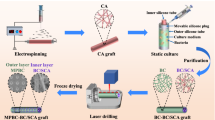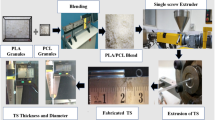Abstract
Poly(l-lactide-co-ε-caprolactone) (PLCL) is a potential material to fabricate scaffolds for vascular tissue engineering. In this work, scaffolds with a multilayered structure comprising a combination of porous and fibrous structures were developed. PLCL was used to fabricate the inner layer of the tubular scaffolds using the freeze-drying technique. The inner layer was then covered by an outer layer fabricated by the melt-spinning technique. The morphology and physical structure of the scaffolds were evaluated through SEM micrographs. The freeze-drying technique formed a porous structure, while the melt-spinning method formed a fibrous structure for the bilayer scaffolds. Physicochemical properties were also investigated by DSC and FTIR measurements; no new functional groups were found to have formed during the freeze-drying or melt-spinning processes. Mechanical properties and fracture mechanism under a tensile loading condition were carefully analyzed to characterize the deformation and fracture behaviors. It was found that the bilayer scaffolds exhibited better mechanical properties than single-layer scaffolds with higher maximum stress at 675.41 kPa, strain at maximum stress at 69.42%, fracture energy at 412.45 kJ/m3 and burst pressure at 147.93 kPa. Porosity, swelling ratio and in vitro biodegradation were measured to ensure its suitability for vascular tissue applications. The bilayer scaffolds with both porous and fibrous structures meet the requirements for vascular tissue engineering.
















Similar content being viewed by others
References
Sarker MD, Naghieh S, Sharma NK, Chen X (2018) 3D biofabrication of vascular networks for tissue regeneration: a report on recent advances. J Pharm Anal 8(5):277–296
Portillo-Lara R, Spencer AR, Walker BW, Shirzaei Sani E, Annabi N (2018) Biomimetic cardiovascular platforms for in vitro disease modeling and therapeutic validation. Biomaterials 198:78–94
Dhulekar J, Simionescu A (2018) Challenges in vascular tissue engineering for diabetic patients. Acta Biomater 70:25–34
Fu J, Wang DA (2018) In situ organ-specific vascularization in tissue engineering. Trends Biotechnol 36(8):834–849
Ratcliffe A (2000) Tissue engineering of vascular grafts. Matrix Biol 19:353–357
Avolio E, Caputo M, Madeddu P (2015) Stem cell therapy and tissue engineering for correction of congenital heart disease. Front Cell Dev Biol 3:1–17
Tara S, Rocco KA, Hibino N, Sugiura T, Kurobe H, Breuer CK, Shinoka T (2013) Vessel bioengineering-development of small-diameter arterial grafts. J Jpn Circ Soc 78:12–19
Konig G, McAllister TN, Dusserre N, Garrido SA, Iyican C, Marini A, Fiorillo A, Avila H, Wystrychowski W, Zagalski K et al (2009) Mechanical properties of completely autologous human tissue engineered blood vessels compared to human saphenous vein and mammary artery. Biomaterials 30:1542–1550
Han J, Lazarovici P, Pomerantz C, Lelkes PI (2011) Co-electrospun blends of PLGA, gelatin, and elastin as potential nonthrombogenic scaffolds for vascular tissue engineering. Biomacromolecules 12:399–408
Jeong SI, Kim SY, Cho SK, Chong MS, Kim KS, Kim H, Lee SB, Lee YM (2007) Tissue-engineered vascular grafts composed of marine collagen and PLGA fibers using pulsatile perfusion bioreactors. Biomaterials 28(6):1115–1122
Lallana E, Donno R, Magri D, Barker K, Nazir Z, Treacher K, Lawrence MJ, Ashford M, Tirelli N (2018) Microfluidic-assisted nanoprecipitation of (PEGylated) poly (d, l-lactic acid-co-caprolactone): effect of macromolecular and microfluidic parameters on particle size and paclitaxel encapsulation. Int J Pharm 548(1):530–539
Pangesty A, Todo M (2018) Development of cylindrical microfibrous scaffold using melt-spinning method for vascular tissue engineering. Mater Lett 228:334–338
Fernández J, Meaurio E, Chaos A, Etxeberria A, Alonso-Varona A, Sarasua JR (2013) Synthesis and characterization of poly (l-lactide/ε-caprolactone) statistical copolymers with well resolved chain microstructures. Polymer 54(11):2621–2631
Zhang T, Wen F, Wu Y, Goh GS, Ge Z, Tan LP, Hui JH, Yang Z (2015) Cross-talk between TGF-beta/SMAD and integrin signaling pathways in regulating hypertrophy of mesenchymal stem cell chondrogenesis under deferral dynamic compression. Biomaterials 38:72–85
Pangesty AI, Arahira T, Todo M (2016) Characterization of tensile mechanical behavior of MSCs/PLCL hybrid layered sheet. J Funct biomater 7:1–13
Stevens MM, George JH (2005) Exploring and engineering the cell surface interface. Mater Biol 310:1135–1138
Kwon IK, Kidoaki S, Matsuda T (2005) Electrospun nano- to microfiber fabrics made of biodegradable copolyesters: structural characteristics, mechanical properties and cell adhesion potential. Biomaterials 26(18):3929–3939
Sarkar K, Gomez C, Zambrano S, Ramirez M, de Hoyos E, Vasquez H, Lozano K (2010) Electrospinning to Forcespinning™. Mater Today 13(11):12–14
L’heureux N, Paˆquet SP, Labbe R, Germain L, Auger FA (1998) A completely biological tissue-engineered human blood vessel. FASEB J 12:47–56
Hiljanen-Vainio M, Karjalainen Seppala J (1996) Biodegradable lactone copolymers 1 Characterization and mechanical behavior of 8-caprolactone and lactide copolymers. J Appl Polym Sci 59:1281–1288
Jeong SI, Kim B-S, Kang SW, Kwon JH, Lee YM, Kim SH, Kim YH (2004) In vivo biocompatibilty and degradation behavior of elastic poly(l-lactide-co-e-caprolactone) scaffolds. Biomaterials 25:5939–5946
Roopmani P, Krishnan UM (2018) Harnessing the pleiotropic effects of atorvastatin-fenofibrate combination for cardiovascular stents. Maters Sci Eng C Mater Biol Appl 92:875–891
Fluke LM, Restrepo RD, Patel S, Hoagland BD, Krevetski LM, Stephenson JT (2016) Strength and histology of a nanofiber scaffold in rats. J Surg Res 205(2):432–439
Horakova J, Mikes P, Saman A, Svarcova T, Jencova V, Suchy T, Heczkova B, Jakubkova S, Jirousova J, Prochazkova R (2018) Comprehensive assessment of electrospun scaffolds hemocompatibility. Mater Sci Eng C Mater Biol Appl 82:330–335
Zhang H, Lou S, Williams GR, Branford-White C, Nie H, Quan J, Zhu LM (2012) A systematic study of captopril-loaded polyester fiber mats prepared by electrospinning. Int J Pharm 439(1–2):100–108
Kijeńska E, Prabhakaran MP, Swieszkowski W, Kurzydlowski KJ, Ramakrishna S (2014) Interaction of Schwann cells with laminin encapsulated PLCL core–shell nanofibers for nerve tissue engineering. Eur Polym J 50:30–38
Cho HH, Han DW, Matsumura K, Tsutsumi S, Hyon SH (2008) The behavior of vascular smooth muscle cells and platelets onto epigallocatechin gallate-releasing poly(l-lactide-co-epsilon-caprolactone) as stent-coating materials. Biomaterials 29(7):884–893
Larrañaga A, Petisco S, Sarasua JR (2013) Improvement of thermal stability and mechanical properties of medical polyester composites by plasma surface modification of the bioactive glass particles. Polym Degrad Stab 98(9):1717–1723
Prabhakaran MP, Venugopal JR, Ramakrishna S (2009) Mesenchymal stem cell differentiation to neuronal cells on electrospun nanofibrous substrates for nerve tissue engineering. Biomaterials 30(28):4996–5003
Acknowledgements
The authors acknowledge financial support from JICA Cooperation and AUN/SEED-Net Collaborative Research Program for this work (Grant Number: 304/PBAHAN/6050351).
Author information
Authors and Affiliations
Corresponding author
Additional information
Publisher's Note
Springer Nature remains neutral with regard to jurisdictional claims in published maps and institutional affiliations.
Rights and permissions
About this article
Cite this article
Tran, T.T., Hamid, Z.A.A., Lai, N.T. et al. Development and mechanical characterization of bilayer tubular scaffolds for vascular tissue engineering applications. J Mater Sci 55, 2516–2529 (2020). https://doi.org/10.1007/s10853-019-04159-3
Received:
Accepted:
Published:
Issue Date:
DOI: https://doi.org/10.1007/s10853-019-04159-3




